Text
Round 1, Match 2: Southern Polychromes
Polychrome pottery types of Mexico.
Ramos Polychrome

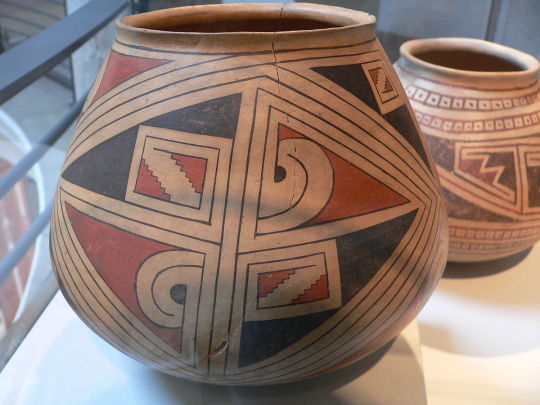
vs.
Trincheras Polychromes

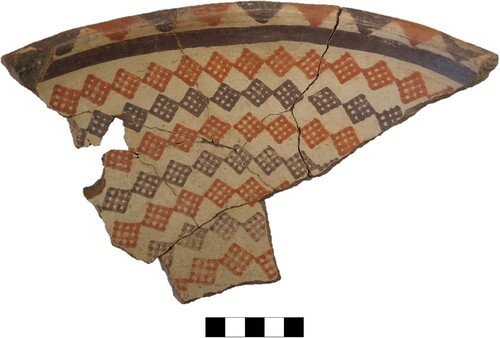
Nogales Polychrome, the most well-described Trincheras polychrome type. From the very southern tip of Arizona, AD 800-1050.
Ramos Polychrome
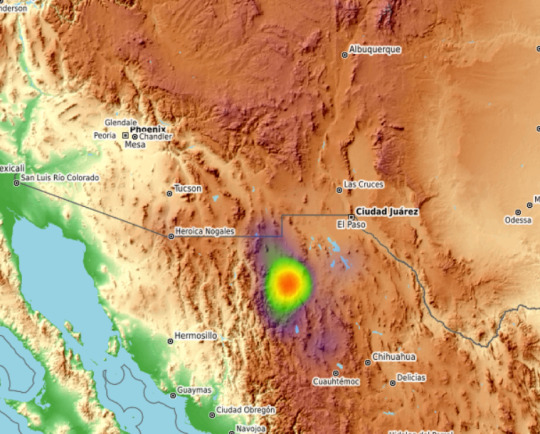

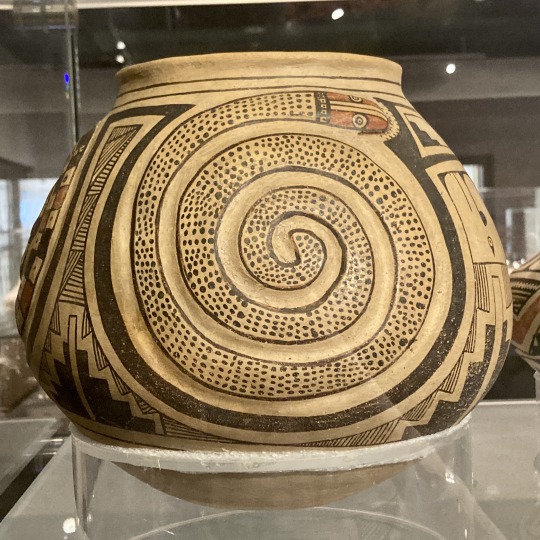
Ramos Polychrome with raised snake motif. Casas Grandes region, Chihuahua, Mexico, 1200-1400.
This right there is possibly one of my favorite archaeological pots of all time. I saw it when I was visiting the Arizona State Museum over spring break for dissertation research reasons and I was enraptured. (I photographed a bunch of pots from the collections for my dissertation that I'm not allowed to post publicly, but this one was on display.)
Ramos Polychrome is the pottery type associated with Casas Grandes, also called Paquimé. A huge, complex, sort-of-Mogollon-ish-but-also-its-own-thing site in northern Chichuahua, Casas Grandes was the center of a vibrant community that mixed Mesoamerican and Mogollon cultural traits. Elaborate multi-story adobe buildings, large agave roasting pits, and robust economy as a probable trade broker between the rest of the Southwest and Mexico. It was settled in the 1100s and occupied until 1450.
Ramos polychrome is red and black on a cream-colored slipped base. Figure depictions of snakes and macaws are extremely common. Effigies of other animals, like dogs and fish, are also extant. Figures and designs tend to be outlined in thin, neat black lines. Ramos polychromes are overwhelmingly jars, rarely bowls.
Trincheras Polychromes


Sherds of Nogales Polychrome (cream-colored background) and Altar Polychrome (darker, reddish background). AD 800-1050, northern Sonora, Mexico.
There are a few, not-well-described Trincheras polychrome types: Nogales Polychrome, Altar Polychrome, Santa Cruz Polychrome. Of those, Nogales Polychrome is the best defined.
"Trincheras" is the name given to the cultural tradition of northern Sonora in the AD 400s-1300s, which, due to it crosscutting the Mexico-US border, has been as yet not deeply studied because international politics and collaboration are hard and also there's been a general lack of interest in the Hohokam in the last 20 years or so for some reason. The people of the Trincheras were probably related to, and interacted with, Hohokam people. Their farming and architectural techniques were similar.
Trincheras polychromes are defined by their purple paint. Instead of black, their hematite-based pigments turned reddish-black on firing, giving them a glittering, purple appearance. These were probably the earliest polychrome pottery created in the Greater Southwest!
17 notes
·
View notes
Text
Round 1, Match 1: Northern Polychromes
I call these the "Northern Polychromes" because they are only (in Fourmile's case) or predominantly (in Salado types' case) found in Arizona and New Mexico.
Salado Polychrome


Left, Gila Polychrome oval bowl (AD 1300-1450); Right, Tonto Polychrome olla (AD 1340-1450). Arizona and New Mexico.
vs.
Fourmile Polychrome
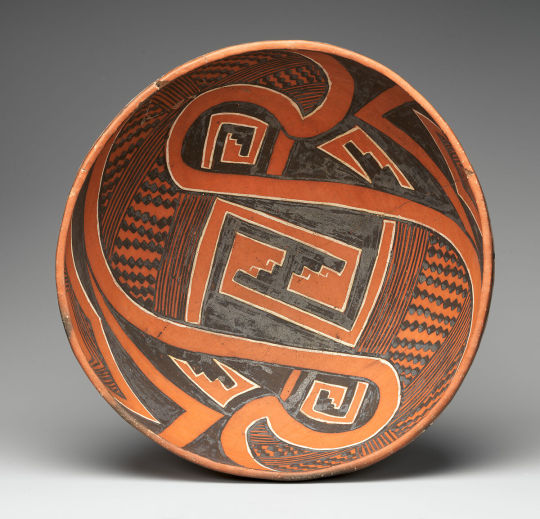
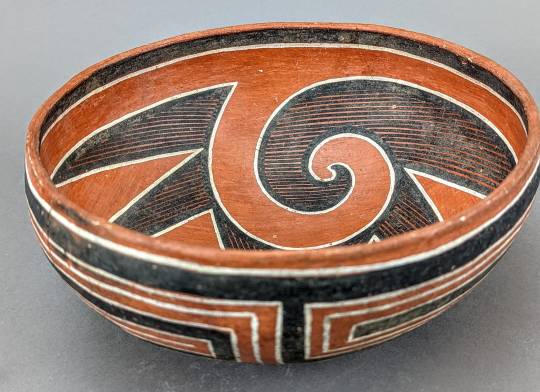
Fourmile Polychrome bowls, AD 1325-1400. Arizona.
More information about each type below the cut:
Salado Polychrome

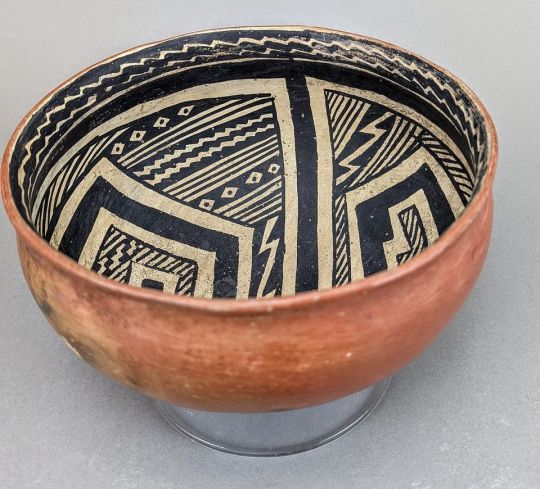
Cliff Polychrome bowl, southeastern Arizona, AD 1350-1450.
Am I biased because this is what I'm writing my dissertation about so I've been thinking about Salado polys nonstop for about 3 years straight? MAYBE. But that's because they're interesting!
Salado polychrome is a collective name for various black, white, and red types of Roosevelt Red Ware. Pinto, Gila, and Tonto polychrome are the three main types, but there are a lot of described type variants.
Around AD 1275, there was a huge drought that lasted 20 years and impacted the whole Southwest. People moved out of the northern Southwest (Mesa Verde, the Four Corners area, southern Utah, northern Arizona) en masse. If you've ever heard of the "mystery" of the "disappearance" of the Anasazi - it's not a mystery, and they didn't disappear. There was a drought, crop failure, social/political instability, and they moved south to where there were population centers and perennial rivers. Some of these immigrants integrated into pre-existing towns; others formed their own enclave settlements.
And right around this time, a new style of pottery became popular in central/southern Arizona and western New Mexico. Like, really popular. Rapidly widespread, all but replacing the previous black-on-white and red-on-buff painted pottery. Gila polychrome (the most common type of Salado polychrome) is notable for being the most widespread decorated ware in the archaeological Southwest. Why?
Archaeologists debated this for decades upon decades. Were the Salado an immigrant group who brought this ware from the Tonto Basin, from the Sinagua, from the Colorado Plateau, from Mexico? Was it a Hohokam development? Was it Mesoamerican influence? You can read the debates back and forth in the 60s-80s and FEEL the palpable frustration!
Modern scholars basically agree that there's no "Salado" culture, that rather Ancestral Pueblo immigrants from the Kayenta and Tusayan regions of northeastern Arizona developed it after they moved to the south. These Salado polychrome pots weren't centrally made and traded widely, they were predominantly made locally to where they were found. But does it represent a retention/renewal of a Kayenta immigrant diaspora identity, or an integrative ideology that brought together immigrants and locals? And where do the Mesoamerican motifs come from?
I'm arguing more from a Kayenta immigrant diaspora identity marker cohesion-after-migration perspective, but it's a super interesting time of upheaval, reorganization, and social dynamism in the Southwest that really set the stage for the modern Pueblos and tribal groups we know today.
Salado polychromes themselves are defined by a red-slipped exterior, a white field, and black designs on white. The black does not touch the red. The exteriors of bowls are usually left plain red, with all the elaborate decoration on the inside. Sometimes there's so much white you can barely see the red. Two- and four-fold rotational symmetry is common; twinned elements are common, but each twin is usually slightly different from the other, not perfect mirrors. Abstracted representations of feathers and feathered serpents are really common too (the Mesoamerican connection). The black paint is organic, relying on a pigment called beeweed - which may have been sourced from back up in the north, a long way to go but clearly important to the people making these pots!
Fourmile Polychrome
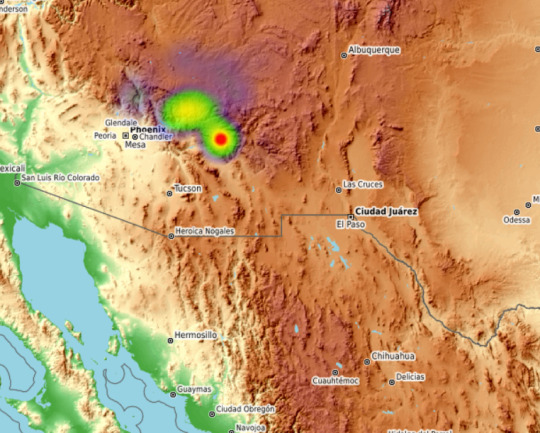

Fourmile Polychrome bowl, AD 1325-1400, central Arizona.
Fourmile Polychrome is a type within White Mountain Red Ware. It's basically contemporaneous with Salado Polychrome, but was made in a different, more northern distribution, by Ancestral Pueblo people who didn't move so far south and congregated around Zuni and east-central Arizona.
Dynamic and bold and more likely to be asymmetrical, Fourmile polychrome is defined by designs in black glaze paint (manganese-based mineral paint with lead in the mix, to make it glossy when it fires and melts) outlined in white.
Both of these types were made by the coil-and-scrape method common to Ancestral (and modern) Pueblo potters (though a small percentage of Salado Polychromes were made by paddle-and-anvil, an argument for the type as an integrative practice...)
24 notes
·
View notes
Text
The Bracket!
Thank you to everyone who was interested and everyone who voted! You chose Tusayan (Sosi/Dogoszhi) and Mesa Verde to represent our black-on-whites, and Plain Smudged and Corrugated to represent our utility ware types! (I was not expecting such a plain smudged sweep - I love to see the enthusiasm!)
So, without any more ado, here is the Finalized Pottery Bracket!
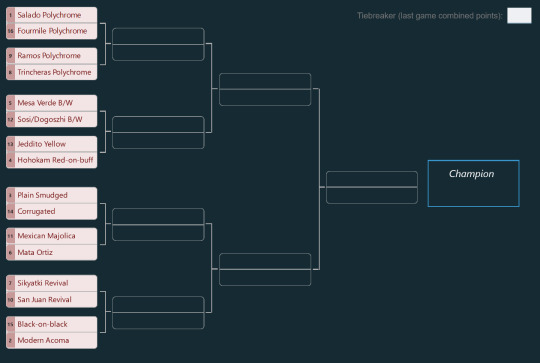
There are SO many more pottery types than these 16, and every time I go to a museum or search up on my favorite Southwest pottery reference websites (New Mexico Office of Archaeology's Pottery Typology Project and Northern Arizona University's American Southwest Virtual Museum) I am reminded of just HOW many different pottery styles there are and how I want to show all of them off...
But these sixteen cover a wide range of styles, locations, and time periods, and give a good sweep of pottery history of the Southwest!
Instead of being separated into seeds, they're grouped by theme. More details on each matchup below:
Tournament 1: Northern Polychromes. Salado Polychrome (that is, Roosevelt Red Ware, Pinto/Gila/Tonto polychrome) vs. Fourmile Polychrome (and the closely associate St. Johns Polychrome). Red, white, and black pottery made in Arizona and New Mexico.
Tournament 2: Southern Polychromes. Ramos Polychrome vs. Trincheras Polychrome. Red, black, purple, and cream pottery made in Chihuahua and Sonora.
Tournament 3: Triumphant Black-on-whites. The return of Mesa Verde Black-on-white and Sosi & Dogoszhi Black-on-white, going head to head!
Tournament 4: Yellow-ish wares. Ancestral Hopi Jeddito Yellow Ware (including the dramatic Sityatki Polychrome) from the Hopi Mesas of Arizona vs. Hohokam red-on-buff types (including Sacaton Red-on-buff and Santa Cruz Red-on-buff) from southern Arizona.
Tournament 5: Return of the Utility Wares. New corrugated and new plain smudged types, still mostly from the Mogollon region both, going to single elimination!
Tournament 6: Mexican Originals. Mexican Majolica, in its distinctively popular type Talavera, the brilliantly colored pottery from the Spanish colonial period in the 1600s, is primarily associated with Puebla, Mexico, which is rather far south of our US Southwest/Mexican Northest topic area, but has for centuries been a popular throughout Spanish-influenced Mexico and the US Southwest. Mata Ortiz, meanwhile, is a modern art pottery style developed in the 1960s in Chihuahua, taking inspiration from the archaeological pottery of Paquimé (including Ramos Polychrome).
Tournament 7: Pueblo Revivals. Sikyatki Revival is the name given to the style of Hopi pottery developed by the Hopi-Tewa potter Nampeyo in the late 1800s based on archaeological pottery from excavations at Sikyatki Village; vs. San Juan Revival, a pottery movement by potters of Ohkay Owingeh Pueblo (formerly known as San Juan Pueblo) starting in the 1930s.
Tournament 8: Modern Pueblo Art. Some of my personal favorite pottery styles picked out from many, many artists working in the Southwest today, Black-on-black (matte black on polished black, or vice versa) pottery developed in the 1910s by a San Ildefonso potter, and still popular primarily in Santa Clara and San Ildefonso Pueblos, vs. Modern Acoma Pottery, a distinctive style in bold reds, whites, and blacks that is just. Gorgeous. You'll see. (I don't mean to diss modern Hopi and Zuni and Navajo and everyone else's styles by not including them, because they're also beautiful and striking, but I had to stop somewhere!)
11 notes
·
View notes
Text
Preliminaries: Battle of the Black-on-Whites!
Black-on-white pottery is far and away the most common decorated pottery style of the ancient Southwest. There are way, way too many to include them all... in fact, there are too many to include even all the ones I want to show off!
So this is the Preliminary Round - four different black-on-white types will go up against each other... only two will move on to represent black-on-whites in the final bracket.

Vote for your favorite!
Information and details about each type under the cut:
Sosi and Dogoszhi Black-on-white

Dogoszhi Black-on-white jar. Northeastern Arizona, 1050-1200.
These are actually two different types within Tusayan White Ware - Sosi B/W and Dogoszhi B/W. However, like I said, Too Many Whitewares, so I'm grouping them together because there's strong overlap.
Sosi B/W can be identified by its bold, black designs, like the one in the compilation above the cut; Dogozshi B/W has similar design layout, but instead of solid black, they're filled with hatchure (thin, parallel lines. Sometimes, like the image above, the body is a Dogoszhi design, while the neck has a more Sosi-like design.
Sosi and Dogozshi Black-on-whites were built with the coil-and-scrape method (built up of many small coils, probably turned on a turning plate called a puki, and then while the clay was still wet, scraped smooth and sometimes polished). The paint was carbon-based and got its color from a plant called beeweed. These were made in the Kayenta and Tusayan regions of north-eastern Arizona.
Mimbres Black-on-white

Bowl with a Frog, Mimbres Black-on-white. Southwestern New Mexico, AD 1000-1150.
One of the most iconic Southwest pottery types. Literally: one of the few pottery types in the Southwest to display a wide range of icons, human and animal figures. Pre-Classic Mimbres bowls used geometric and rotational symmetry designs more often, mixing bold lines and hatchure; Classic Mimbres bowls tend to have a linear design around the rim, and then a human or animal design on the inside. Various types of figures are seen, but primarily birds, insects, amphibians/reptiles, and twin human figures, in hematite-based paint.
Mimbres bowls are among the most popular to be sold by looters on the black market. Worse, a very large number of the most dramatic Mimbres bowls come from burials; if you see an archaeological pot for sale with an animal design like this, it was almost certainly stolen out of a grave. You can especially suspect this when the bowls have small circular holes smashed or drilled in the center, usually obscuring the figure partially. Archaeologists call these kill holes, from the idea that the pot was "killed" to end its use-life when it was buried with the deceased person. If you see a Mimbres pot with a kill-hole, odds are very good (something like 80%) that it came from a burial. These displayed bowls here are verified to come from non-burial contexts.
Chaco Black-on-white
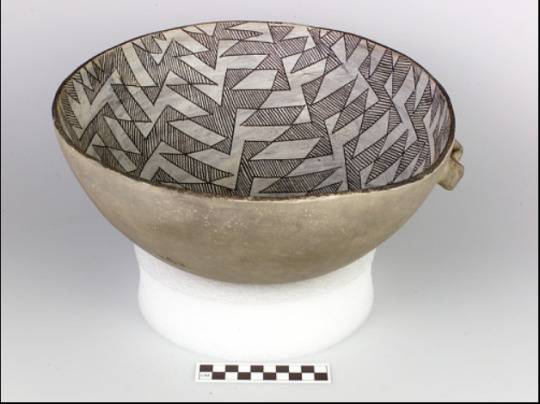
Chaco (or Gallup) Black-on-white. Pueblo Bonito, Chaco Canyon, north-western New Mexico, AD 1000-1100.
Chaco Canyon! One of the most dramatic, interesting, and still mysterious aspects of the Ancestral Southwest. In a canyon in New Mexico, multiple palatial "Great Houses" were built, with hundreds of rooms, large and regimented plazas, massive kivas (circular subterranean religious buildings), and an incredible amount of decoration and pageantry. Pueblo Bonito, the largest of the Chaco Great Houses, is proven to have had a matrilineal elite/noble lineage. How many people actually lived in the Great Houses? Were they palaces, communal centers, worship centers? Were the Chaco elite a priestly class or a noble caste or a bit of both? How did they mobilize people throughout the Chaco sphere of influence to bring timbers down from the mountains a hundred kilometers away to build these Great Houses? There are a lot of things archaeologists still argue about. Pueblo and Navajo oral histories describe Chaco as an overreach of power that their ancestors eventually rejected, leading to the collapse of Chaco Canyon as a center of social influence throughout the Southwest around 1100. (Modern Pueblo and Navajo relationships to Chaco are complicated. It was an overreach of power, but also an incredible ancestral polity.) Until then, it was certainly a socially, politically, and religiously powerful force.
You can also see this in the pottery: this style of hatchure, the narrow black-and-white lines, was massively popular in Chaco Canyon and seems to have kind of ripple-effected out to the rest of the Southwest who were in or near the Chaco sphere of influence. Hatchure is very common in a lot of black-on-white wares, but very close, very narrow, very even hatchure is strongly associated with Chaco Canyon.

Cylinder jars for chocolate-drinking, as described and confirmed by Dr. Patricia Crown. Chaco Canyon, Pueblo Bonito, 1000-1100.
Also, Chaco Black-on-white cylinder jars were used for a chocolate-drinking ritual, indicating cultural connections, religious ties, and trade routes to Mesoamerica and Maya communities far to the south in Mexico in the 900s-1000s. It's an important thing to remember: None of these cultures or time periods were static, and were almost never insular.
Mesa Verde Black-on-white

Mesa Verde Black-on-white bowls. Southwestern Colorado/northwestern New Mexico, AD 1150-1280.
An immensely popular white ware style, Mesa Verde Black-on-white is associated with the Ancestral Pueblo settlements - including the dramatic and famous cliff dwellings, like Cliff Palace. Bold, heavy, repeating geometric designs in carbon-based paint are the most common, but there are hatched designs and some areas that used mineral paints as well. Paintbrushes to apply these painted designs were made of yucca.
Some of the most fun and famous Mesa Verde B/W vessels are the mugs of Mug House, a site so named because a bunch of mugs were found in it.
#thank you for these!!#I wanted to be careful about only using ones where the source offered a provenience context#I didn’t think to look on TDAR#I’m not used to finding anything useful towards what I’m looking for when I look on TDAR :’)#Mimbres#Pottery
74 notes
·
View notes
Text
Preliminaries: Battle of the Black-on-Whites!
Black-on-white pottery is far and away the most common decorated pottery style of the ancient Southwest. There are way, way too many to include them all... in fact, there are too many to include even all the ones I want to show off!
So this is the Preliminary Round - four different black-on-white types will go up against each other... only two will move on to represent black-on-whites in the final bracket.

Vote for your favorite!
Information and details about each type under the cut:
Sosi and Dogoszhi Black-on-white

Dogoszhi Black-on-white jar. Northeastern Arizona, 1050-1200.
These are actually two different types within Tusayan White Ware - Sosi B/W and Dogoszhi B/W. However, like I said, Too Many Whitewares, so I'm grouping them together because there's strong overlap.
Sosi B/W can be identified by its bold, black designs, like the one in the compilation above the cut; Dogozshi B/W has similar design layout, but instead of solid black, they're filled with hatchure (thin, parallel lines. Sometimes, like the image above, the body is a Dogoszhi design, while the neck has a more Sosi-like design.
Sosi and Dogozshi Black-on-whites were built with the coil-and-scrape method (built up of many small coils, probably turned on a turning plate called a puki, and then while the clay was still wet, scraped smooth and sometimes polished). The paint was carbon-based and got its color from a plant called beeweed. These were made in the Kayenta and Tusayan regions of north-eastern Arizona.
Mimbres Black-on-white

Bowl with a Frog, Mimbres Black-on-white. Southwestern New Mexico, AD 1000-1150.
One of the most iconic Southwest pottery types. Literally: one of the few pottery types in the Southwest to display a wide range of icons, human and animal figures. Pre-Classic Mimbres bowls used geometric and rotational symmetry designs more often, mixing bold lines and hatchure; Classic Mimbres bowls tend to have a linear design around the rim, and then a human or animal design on the inside. Various types of figures are seen, but primarily birds, insects, amphibians/reptiles, and twin human figures, in hematite-based paint.
Mimbres bowls are among the most popular to be sold by looters on the black market. Worse, a very large number of the most dramatic Mimbres bowls come from burials; if you see an archaeological pot for sale with an animal design like this, it was almost certainly stolen out of a grave. You can especially suspect this when the bowls have small circular holes smashed or drilled in the center, usually obscuring the figure partially. Archaeologists call these kill holes, from the idea that the pot was "killed" to end its use-life when it was buried with the deceased person. If you see a Mimbres pot with a kill-hole, odds are very good (something like 80%) that it came from a burial. These displayed bowls here are verified to come from non-burial contexts.
Chaco Black-on-white

Chaco (or Gallup) Black-on-white. Pueblo Bonito, Chaco Canyon, north-western New Mexico, AD 1000-1100.
Chaco Canyon! One of the most dramatic, interesting, and still mysterious aspects of the Ancestral Southwest. In a canyon in New Mexico, multiple palatial "Great Houses" were built, with hundreds of rooms, large and regimented plazas, massive kivas (circular subterranean religious buildings), and an incredible amount of decoration and pageantry. Pueblo Bonito, the largest of the Chaco Great Houses, is proven to have had a matrilineal elite/noble lineage. How many people actually lived in the Great Houses? Were they palaces, communal centers, worship centers? Were the Chaco elite a priestly class or a noble caste or a bit of both? How did they mobilize people throughout the Chaco sphere of influence to bring timbers down from the mountains a hundred kilometers away to build these Great Houses? There are a lot of things archaeologists still argue about. Pueblo and Navajo oral histories describe Chaco as an overreach of power that their ancestors eventually rejected, leading to the collapse of Chaco Canyon as a center of social influence throughout the Southwest around 1100. (Modern Pueblo and Navajo relationships to Chaco are complicated. It was an overreach of power, but also an incredible ancestral polity.) Until then, it was certainly a socially, politically, and religiously powerful force.
You can also see this in the pottery: this style of hatchure, the narrow black-and-white lines, was massively popular in Chaco Canyon and seems to have kind of ripple-effected out to the rest of the Southwest who were in or near the Chaco sphere of influence. Hatchure is very common in a lot of black-on-white wares, but very close, very narrow, very even hatchure is strongly associated with Chaco Canyon.

Cylinder jars for chocolate-drinking, as described and confirmed by Dr. Patricia Crown. Chaco Canyon, Pueblo Bonito, 1000-1100.
Also, Chaco Black-on-white cylinder jars were used for a chocolate-drinking ritual, indicating cultural connections, religious ties, and trade routes to Mesoamerica and Maya communities far to the south in Mexico in the 900s-1000s. It's an important thing to remember: None of these cultures or time periods were static, and were almost never insular.
Mesa Verde Black-on-white

Mesa Verde Black-on-white bowls. Southwestern Colorado/northwestern New Mexico, AD 1150-1280.
An immensely popular white ware style, Mesa Verde Black-on-white is associated with the Ancestral Pueblo settlements - including the dramatic and famous cliff dwellings, like Cliff Palace. Bold, heavy, repeating geometric designs in carbon-based paint are the most common, but there are hatched designs and some areas that used mineral paints as well. Paintbrushes to apply these painted designs were made of yucca.
Some of the most fun and famous Mesa Verde B/W vessels are the mugs of Mug House, a site so named because a bunch of mugs were found in it.
74 notes
·
View notes
Text
Preliminaries: War of the Utility Wares!
Most pottery you find in archaeological sites isn't painted. Most pottery is unslipped, undecorated utility ware - with the assumption that "utility" typically here means "cooking over a fire." Sometimes grain storage. Usually cooking, though.
It doesn't mean they can't be beautiful in their own right. And one of my friends is working on a dissertation which among other things argues that "surface treatments" like incising and corrugation should be considered "decoration" too, when usually in archaeology "decorated" means "painted." There were lots and lots and lots of types of utility wares. Some were plain. Some were gorgeous.
So this is a Preliminary Round - four different styles traditionally called utility ware will go up against each other... only two will move on to represent utility wares in the final bracket.
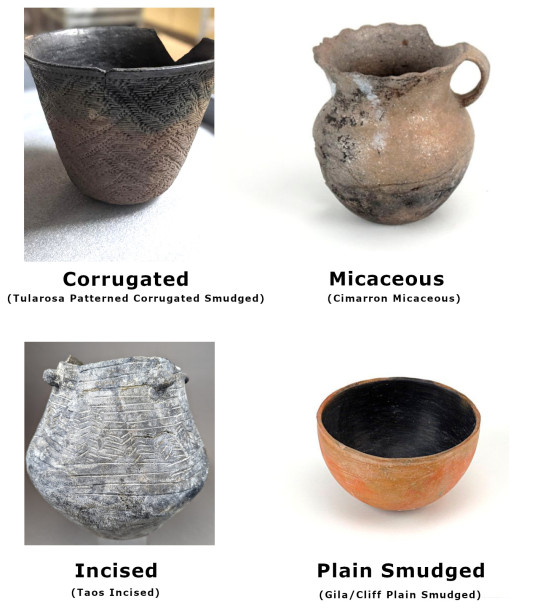
Vote for your favorite: More information about each is under the cut:
Corrugated
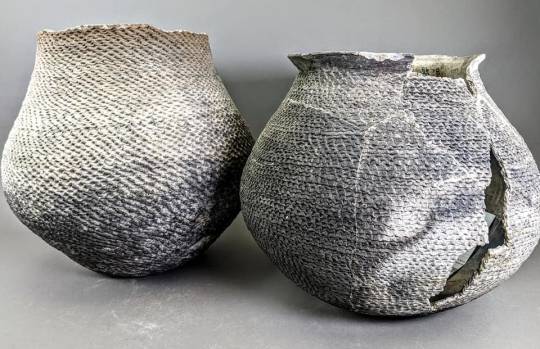
Mesa Verde Corrugated jars. Southern Colorado, AD 1100-1300.
There are SO many different types of corrugated pottery; if I listed them all we'd be here all day. However, they all have commonalities: They were primarily (though not exclusively) made in the Mogollon cultural region, primarily (though not exclusively) plain and unpainted, and primarily (though not exclusively) used for cooking.
In this region, potters don't use pottery wheels. Pots are hand-built, typically from coil-building: using many thin coils to build up the shape of the pot. For most pots, those coils are scraped smooth as they're still wet. But for corrugated pots, those coils are only scraped smooth on the inside. The outside coils are instead pressed using a tool or the potter's thumb to make a patterned, scaled, or woven texture. Corrugation, due to its association with cooking pots, is not typically considered "decoration" by archaeologists, but it creates beautiful and captivating patterns.
Micaceous

Micaceous Bowl with Etched Flowers. Made by Virginia Romero (Taos Pueblo, 1896-1998).
In northern New Mexico, there are golden-red clays with a lot of sparkly mica in them. The mica self-tempers the clay, and creates a lovely shimmering effect when you see the pots in person. There's evidence of polished micaceous pottery being made as early as the 1300s, but it really took off as a popular type of cooking ware in the 1500s-1600s. In this time, it was made primarily by norther Pueblos like Taos, Picuris, and Nambe, but was enthusiastically adopted by the Jicarilla Apache as well, who have strong social ties to those northern Pueblos. Cimarron Micaceous, the handled jar seen above the cut, is a 1600s Apache micaceous pottery style.
Micaceous pottery is still extremely popular with Native potters today. Some of it is as an art form, with many different experiments in structure and style, but some people still swear by cooking in these micaceous clay pots - beans just taste better when cooked in clay instead of metal!
Incised

Taos Incised jar sherd. Northern New Mexico, AD 1050-1300.
Incised ware is SO underappreciated. However I am also biased because for the past three or four summers I have worked on an archaeology project in the Taos area and we find so much of it.
Incised designs are carved into the wet clay. Usually, these are not painted. Incised pottery is very common on the Great Plains, but less so in the Southwest. The Northern Pueblos like Taos and Picuris, however, has long-standing interactions with Plains groups, trading corn and buffalo hides, holding market days together, Picuris and Taos people fleeing the Spanish invasion to live in Kansas with their Apache allies. This is also visible in the sharing of pottery styles in the northern Pueblos, where incised ware is common. Parallel lines that mimic corrugation, chevrons, and herringbone patterns are common.
Plain Smudged
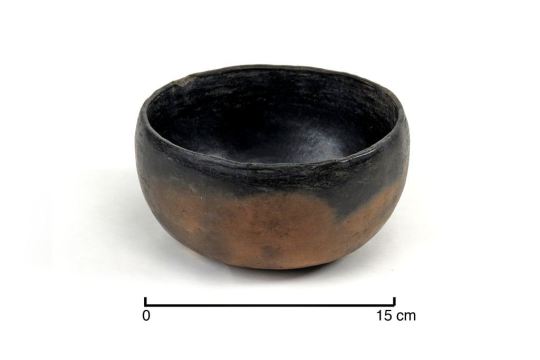
Reserve Plain Smudged, Mogollon Highlands, AD 600-1250.
As I described in my pottery jargon post, "smudging" is a method of getting that shiny black interior during the firing stage. During firing, different levels of oxygen will cause the minerals in the clay to turn different colors. An oxidized environment (high oxygen) turns iron-rich clays red; a recducing atmosphere (restricted oxygen) plus an infusion of carbon turns them black. To smudge a pot, the inside is polished, and then in the firing pit is covered with ash and charcoal. This puts a lot of carbon on the surface, and blocks the oxygen from reaching it. When the pot comes out of the fire, the part that was covered in charcoal will be shiny black. This was another pottery style particularly popular in Mogollon areas.
47 notes
·
View notes
Text
Some Maps
To get a sense of the locations I'll be talking about.
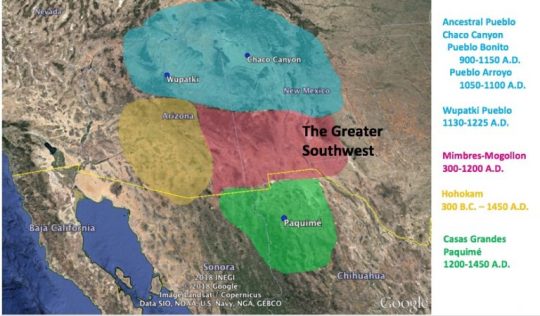
This map from the University of Florida displays the general extent of Southwestern "culture areas" of the past ~2000 years, mapping four major cultural traditions defined by suites of similar architecture and artifacts. It's important to note that, 1000 or 800 or 600 years ago, it's unlikely that people from the marked regions would have considered themselves All The Same People; rather, this is an archaeological designation of material culture similarities that represents likelihood that people were operating from a similar cultural logic.
Here's a different one, by Catherine Gilman and Kathleen Bader:

Is Sinagua its own distinct cultural group, or does it represent the place where the borders and the styles and the logics of Hohokam, Pueblo, Mogollon, and Patayan cultural trends overlapped and intermixed? Should "Salado" be considered a culture in its own right? (In my dissertation I treat the answer as No Not Really!) Should the Trincheras tradition be treated as a distinct cultural group, or a subset of Hohokam, and where is that boundary? How big was the Casas Grandes sphere of influence?
These give a good sense of the distributions of various pottery traditions, the spheres of cultural influence, and the difficulty of defining cultural boundaries of the past.
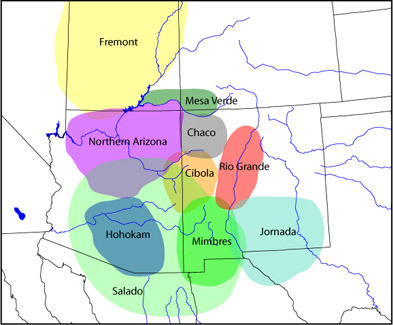
This map by Matthew Peeples shows ceramic typological regions - that is, areas that were making similar ceramic types, with similar clays, technologies, and decorative methods.
And, to put it in perspective, the modern locations of Pueblos, tribal nations, Indian Communities, and other reservations:


It can very quickly get difficult to picture where everything is in relation to each other, so I hope these maps will serve as a useful reference!
33 notes
·
View notes
Text
A crash course in some vocabulary
Archaeology, like all sciences, has a lot of specialized jargon we use to talk about pottery. To make sure everyone’s on the same page, here’s a list of some common terms I’ll be using, what they mean, and how to pronounce them.
~ 🏺🏺🏺 ~
Ware: A broader term for a technological/cultural tradition in pottery. Typically, construction method, color, clay type, temper type, and paint type are what defines a “ware.” So Chuska Gray Ware is unslipped, usually unpainted gray clay with crushed black basalt temper. Roosevelt Red Ware is red-slipped clay with sand temper and carbon-based paint. Hohokam Buff Ware is unslipped or cream-slipped buff-colored clay with coarse sand temper, created using a paddle-and-anvil forming method and painted with red paint.
Type: Within a ware, a type is a more narrowly specific decorative style. Roosevelt Red Ware has multiple types within it, such as Salado Red (unpainted red-slipped), Pinto Black-on-red (black paint on the red in a specific radially symmetric interlocked hatched-and-bold pattern), Pinto Polychrome (same decorative style but on a white-slipped interior field), Gila Polychrome (red exterior, white-slipped interior, a usually-broken black band around the rim, black painted designs in a two- or -four-fold symmetry), Tonto Polychrome (bolder and less symmetric black-and-white designs on a red field), Cliff Polychrome, Dinwiddie Polychrome, Nine Mile Polychrome… different stylistic variations on the Roosevelt Red Ware technological/visual core. You can read more about categorizations here.
A note on naming conventions: Pottery in this archaeological tradition tends to have a two-part name: a location where it was first defined and described, and a colorway. Wares tend to be “[Broad location or broad cultural group] [Color] Ware”; types tend to be “[Specific site] [paint color]-on-[clay color].” So within Tusayan White Ware is Flagstaff Black-on-white.
———
Gila: A river in southern Arizona and a bit of New Mexico, and a lizard and a polychrome type named after it. Pronounced hee-la.
Hohokam: An archaeological term for a Native American cultural group that lived in southern Arizona and northern Sonora, defined by traits like red-on-buff pottery, massive canal systems for field irrigation, and platform mounds. It comes from the O'odham-language word huhugham, “ancestors.” They are the ancestors of the modern Tohono O’odham and Akimel O’odham people (it’s a little bit more complicated than that but that’s basically the case.)
Mogollon: An archaeological term for a Native American cultural group from central New Mexico, eastern Arizona, and northern Chihuahua. Most iconic trait is the elaborate range of corrugated and smudged pottery. Named after the Mogollon Rim, the geological formation that marks the edge of the Colorado Plateau and a drastic change in geology and climate in the northern Southwest and the southern Southwest. Along with the Ancestral Pueblo, the Mogollon culture are ancestors of modern southern Rio Grande and Zuni pueblos. Pronounced moh-guh-yon.
Olla: A water jar with a wide body and narrow neck. Pronounced oy-ya.
Polychrome: Pottery that is three or more colors (poly+chrome), most often meaning red, white, and black.
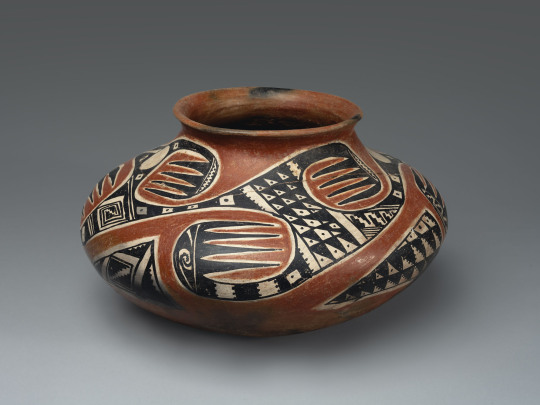
A Tonto Polychrome olla. Southeastern Arizona, 1350-1450.
Pueblo: A collective term for Native people of the Southwest US (particularly in the Rio Grande river watershed, but also Hopi and Zuni) who share cultural traits and history—most immediately notably, a tradition of living in square adobe houses in large villages, which are also each called pueblos. Ancestral Pueblo is the term for the archaeologically-defined cultural group that share these similar traits and are, generally, from the northern half of New Mexico and Arizona, and a southern strip of Colorado and Utah. The Ancestral Puebloans were formerly called “Anasazi” but that has fallen out of favor due to pushback from modern Pueblos. Also, each modern Pueblo prefers to be called a Pueblo rather than a tribe in most cases—so you say the Pueblo of Acoma, the Pueblo of Ohkay Owingeh, Picuris Pueblo, Taos Pueblo, the Pueblo of Zuni, etc.
Temper: Non-clay bits that are added to natural clays to make them easier to work with. When you buy clay from a store now, it’s already mixed and processed and ready to use. When you find clay out in nature, it’s almost never so easy. Typically, you have to mine/harvest clay from riverbanks or cliffsides, and it’s hard and dried; then you have to grind the hard clay up into fine particles, and mix them with water. But natural clays are often puddly and don’t always hold together well, so you add temper, something hard and grainy to make your wet clay stick together more easily and make it good to work with! Temper can be sand, ground-up rock, ground-up shell, or even ground-up bits of other broken pottery. What different people used as temper is one defining feature of a pottery ware and pottery tradition.
Sherd: A broken bit of pottery. NOT shard. When it’s pottery, it’s “sherd.”
Slip: Very runny wet clay. It’s used to help attach clay pieces together, but more pertinently here, plain-colored pots are covered with an even layer of bolder-colored clay slip to get the desired color pot.
Smudging: A decorative style that potters made during the firing stage. They would have open pit-fires for firing their pottery, and cover the desired part of the pot with a layer of charcoal or ash. This creates a carbonized, reducing environment—that is, a lot of carbon, and little oxygen. This creates a smooth, inky black finish on the completed pot.
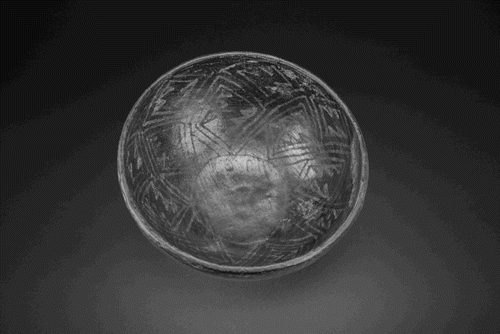
A Starkweather Smudged bowl. Mogollon, western New Mexico, AD 900-1200.
Vessel: Another word for pot, basically. Means a ceramic container of some sort. Bowls, jars, ladles, pitchers, mugs, etc are all vessels; effigies and statuettes are not.
42 notes
·
View notes
Text
Hello and welcome to the US Southwest/Mexican Northwest Pottery Bracket!
Or, the "Greater Southwest," if you're writing from a USAmerican perspective, which I am.

The Greater Southwest was and is a vibrant, multicultural place, with a long history of settlement, movement, interaction, art, philosophy, and cultural exchange. And it's the home of some of the most striking and beautiful pottery in the world. No, I'm not biased.
The Greater Southwest has great, workable, colorful clays, and a hot dry environment that makes artifacts preserve well over the centuries. So there are a LOT of examples of pottery, from its initial use in this region 3000-some years ago to the modern art form made today.
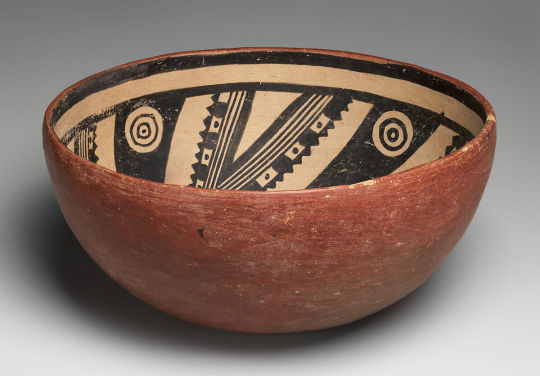
A Gila Polychrome bowl, southeastern Arizona, 1300-1450.
I'm @specialagentartemis and I'm an archaeology PhD student studying Southwestern pottery. This is my excuse to ramble about my topic of study and interest, and share a little bit about it with the world. And make it fun. I'll present the pottery... and YOU vote on it! Based on how pretty it is, or how interesting, or if it was made by your tribe, or whatever other criteria you like. This isn't voting on the objective best pottery, just tumblr's favorite.
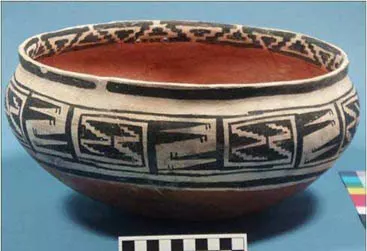
A Nine Mile Polychrome bowl, southeastern Arizona, 1375-1450.
In the spreadsheet I'm working with for my research assistanceship doing ceramic data analysis, there are 1,352 different pottery types listed. That is So Many. I will not be having you vote on every single one. I've pulled out 18 wares and types that I think exemplify Southwestern ceramic history across various times, places, styles, and cultures, from the AD 800s to the present day.
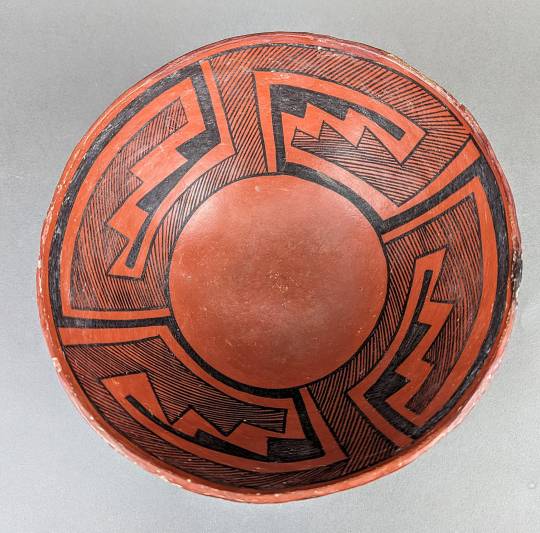
A Wingate Black-on-red bowl, western New Mexico, 1030-1175.
If you have questions, comments, propaganda for your favorite pottery, or a nomination for a pottery type to include, feel free to drop an ask!
I will not knowingly post any photos of pottery from burials.
(and, as traditional, I'll tag some fellow bracket pollsters who may be interested: @goldenapplebracket @gayest-classiclit @namedafterflowerstournament)
113 notes
·
View notes